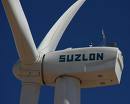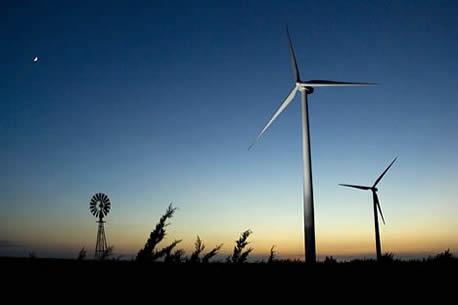PETER S. GOODMAN, The New York Times, November 2, 2008
Newton, Iowa – Like his uncle, his grandfather and many of their neighbors, Arie Versendaal spent decades working at the Maytag factory here, turning coils of steel into washing machines.
When the plant closed last year, taking 1,800 jobs out of this town of 16,000 people, it seemed a familiar story of American industrial decline: another company town brought to its knees by the vagaries of global trade.
Except that Mr. Versendaal has a new factory job, at a plant here that makes blades for turbines that turn wind into electricity. Across the road, in the old Maytag factory, another company is building concrete towers to support the massive turbines. Together, the two plants are expected to employ nearly 700 people by early next year.
“Life’s not over,” Mr. Versendaal says. “For 35 years, I pounded my body to the ground. Now, I feel like I’m doing something beneficial for mankind and the United States. We’ve got to get used to depending on ourselves instead of something else, and wind is free. The wind is blowing out there for anybody to use.”
From the faded steel enclaves of Pennsylvania to the reeling auto towns of Michigan and Ohio, state and local governments are aggressively courting manufacturing companies that supply wind energy farms, solar electricity plants and factories that turn crops into diesel fuel.
This courtship has less to do with the loftiest aims of renewable energy proponents — curbing greenhouse gas emissions and lessening American dependence on foreign oil — and more to do with paychecks. In the face of rising unemployment, renewable energy has become a crucial source of good jobs, particularly for laid-off Rust Belt workers.
Amid a presidential election campaign now dominated by economic concerns, wind turbines and solar panels seem as ubiquitous in campaign advertisements as the American flag.
No one believes that renewable energy can fully replace what has been lost on the American factory floor, where people with no college education have traditionally been able to finance middle-class lives. Many at Maytag earned $20 an hour in addition to health benefits. Mr. Versendaal now earns about $13 an hour.
Still, it’s a beginning in a sector of the economy that has been marked by wrenching endings, potentially a second chance for factory workers accustomed to layoffs and diminished aspirations.
In West Branch, Iowa, a town of 2,000 people east of Iowa City, workers now assemble wind turbines in a former pump factory. In northwestern Ohio, glass factories suffering because of the downturn in the auto industry are retooling to make solar energy panels.
“The green we’re interested in is cash,” says Norman W. Johnston, who started a solar cell factory called Solar Fields in Toledo in 2003.
The market is potentially enormous. In a report last year, the Energy Department concluded that the United States could make wind energy the source of one-fifth of its electricity by 2030, up from about 2 percent today. That would require nearly $500 billion in new construction and add more than three million jobs, the report said. Much of the growth would be around the Great Lakes, the hardest-hit region in a country that has lost four million manufacturing jobs over the last decade.
Throw in solar energy along with generating power from crops, and the continued embrace of renewable energy would create as many as five million jobs by 2030, asserts Daniel M. Kammen, director of the Renewable and Appropriate Energy Laboratory at the University of California, Berkeley, and an adviser to the presidential campaign of Senator Barack Obama.
The unfolding financial crisis seems likely to slow the pace of development, making investment harder to secure. But renewable energy has already gathered what analysts say is unstoppable momentum. In Texas, the oil baron T. Boone Pickens is developing what would be the largest wind farm in the world. Most states now require that a significant percentage of electricity be generated from wind, solar and biofuels, effectively giving the market a government mandate.
And many analysts expect the United States to eventually embrace some form of new regulatory system aimed at curbing global warming that would force coal-fired electricity plants to pay for the pollution they emit. That could make wind, solar and other alternative fuels competitive in terms of the cost of producing electricity.
Both presidential candidates have made expanding renewable energy a policy priority. Senator Obama, the Democratic nominee, has outlined plans to spend $150 billion over the next decade to spur private companies to invest. Senator John McCain, the Republican nominee, has spoken more generally of the need for investment.
In June, more than 12,000 people and 770 exhibitors jammed a convention center in Houston for the annual American Wind Energy Association trade show. “Five years ago, we were all walking around in Birkenstocks,” says John M. Brown, managing director of a turbine manufacturer, Entegrity Wind Systems of Boulder, Colo., which had a booth on the show floor. “Now it’s all suits. You go to a seminar, and it’s getting taught by lawyers and bankers.”
So it goes in Iowa. Perched on the edge of the Great Plains — the so-called Saudi Arabia of wind — the state has rapidly become a leading manufacturing center for wind power equipment.
“We are blessed with certainly some of the best wind in the world,” says Chet Culver, Iowa’s governor.
Maytag was born in Newton more than a century ago. Even after the company swelled into a global enterprise, its headquarters remained here, in the center of the state, 35 miles east of Des Moines.
“Newton was an island,” says Ted Johnson, the president of local chapter of the United Automobile Workers, which represented the Maytaggers. “We saw autos go through hard times, other industries. But we still had meat on our barbecues.”
The end began in the summer of 2005. Whirlpool, the appliance conglomerate, swallowed up Maytag. As the word spread that local jobs were doomed — Whirlpool was consolidating three factories’ production into two — workers unloaded their memorabilia at Pappy’s Antique Mall downtown: coffee mugs, buttons, award plaques.
“If it said Maytag on it, we bought it,” says Susie Jones, the store manager. “At first, I thought the stuff had value. Then, it was out of the kindness of my heart. And now I don’t have any heart left. It don’t sell. People are mad at them. They ripped out our soul.”
When the town needed a library, a park or a community college, Maytag lent a hand. The company was Newton’s largest employer, its wages paying for tidy houses, new cars, weddings, retirement parties and funerals.
As Whirlpool made plans to shutter the factory, state and county economic development officials scrambled to attract new employers. In June 2007, the local government dispatched a team to the American Wind Energy Association show in Los Angeles. Weeks later, a company called TPI Composites arrived in Newton to have a look.
Based in Arizona, TPI makes wind turbine blades by layering strips of fiberglass into large molds, requiring a long work space. The Maytag plant was too short. So local officials showed TPI an undeveloped piece of land encircled by cornfields on the edge of town where a new plant could be built.
Although TPI was considering a site in Mexico with low labor costs, Newton had a better location. Rail lines and Interstate 80 connect it to the Great Plains, where the turbines are needed. Former Maytag employees were eager for work, and the community college was ready to teach them blade-making.
Newton won. In exchange for $6 million in tax sweeteners, TPI promised to hire 500 people by 2010. It has already hired about 225 and is on track to have a work force of 290 by mid-November.
“Getting 500 jobs in one swoop is like winning the lottery,” says Newton’s mayor, Chaz Allen. “We don’t have to just roll over and die.”
On a recent afternoon, workers inside the cavernous TPI plant gaze excitedly at a crane lifting a blade from its mold and carrying it toward a cleared area. Curved and smooth, the blade stretches as long as a wing of the largest jets. One worker hums the theme from “Jaws” as the blade slips past.
Larry Crady, a worker, takes particular pleasure in seeing the finished product overhead, a broad grin forming across his goateed face. He used to run a team that made coin-operated laundry machines at Maytag. Now he supervises a team that lays down fiberglass strips between turbine moldings. He runs his hand across the surface of the next blade for signs of unevenness.
“I like this job more than I did Maytag,” Mr. Crady says. “I feel I’m doing something to improve our country, rather than just building a washing machine.”
Ask him how long he spent at Maytag and Mr. Crady responds precisely: “23.6 years.” Which is to say, 6.4 years short of drawing a pension whose famously generous terms compelled so many to work at the Maytag plant. “That’s what everyone in Newton was waiting on,” he says. “You could get that 30 and out.”
But he is now optimistic about the decades ahead. “I feel solid,” he says. “This is going to be the future. This company is going to grow huge.”
The human resources office at TPI is overseen by Terri Rock, who used to have the same position at Maytag’s corporate headquarters, where she worked for two decades. In her last years there, her job was mostly spent ending other people’s jobs.
“There was a lot of heartache,” she says. “This is a small town, and you’d have to let people go and then see them at the grocery store with their families. It was a real tough job at the end.”
Now, Ms. Rock starts fresh careers, hiring as many as 20 people a week. She enjoys the creative spirit of a start-up. “We’re not stuck with the mentality of ‘this is how we’ve done it for the last 35 years,’ ” she says.
Maytag is gone in large part because of the calculus driving globalization: household appliances and so many other goods are now produced mostly where physical labor is cheaper, in countries like China and Mexico. But wind turbines and blades are huge and heavy. The TPI plant is in Iowa largely because of the costs of shipping such huge items from far away.
“These are American jobs that are hard to export,” says Crugar Tuttle, general manager of the TPI plant.
And these jobs are part of a build-out that is gathering force. More than $5 billion in venture capital poured into so-called clean energy technology industries last year in North America and Europe, according to Cleantech, a trade group. In North America, that represented nearly a fifth of all venture capital, up from less than 2 percent in 2000.
“Everybody involved in the wind industry is in a massive hurry to build out capacity,” Mr. Tuttle says. “It will feed into a whole local industry of people making stuff, driving trucks. Manufacturing has been in decline for decades. This is our greatest chance to turn it around. It’s the biggest ray of hope that we’ve got.”
Those rays aren’t touching everyone, though. Hundreds of former Maytag workers remain without jobs, or stuck in positions paying less than half their previous wages. Outside an old union hall, some former Maytaggers share cigarettes and commiserate about the strains of starting over.
Mr. Johnson, the former local president, is jobless. At 45, he has slipped back into a world of financial hardship that he thought he had escaped. His father was a self-employed welder. His mother worked at an overalls factory.
“I grew up in southern Iowa with nothing,” he says. “If somebody got a new car, everybody heard about it.”
When Maytag shut down, his $1,100-a-week paycheck became a $360 unemployment check. He and his wife divorced, turning what once was a two-income household into a no-income household. He sold off his truck, his dining room furniture, his Maytag refrigerator — all in an effort to pay his mortgage. Last winter, he surrendered his house to foreclosure.
Mr. Johnson has applied for more than 220 jobs, he says, from sales positions at Lowe’s to TPI. He has yet to secure an interview. His unemployment benefits ran out in May. He no longer has health insurance. He recently broke a tooth where a filling had been, but he can’t afford to have it fixed.
When his teenage daughter, who lives with him, complained of headaches, he paid $1,500 out of pocket for an M.R.I. The doctor found a cyst on her brain. And how is she doing now? Mr. Johnson freezes at the question. He is a grown man with silver hair, a black Harley-Davidson T-shirt across a barrel chest, and calloused hands that could once bring a comfortable living. He tries to compose himself, but tears burst. “I’m sorry,” he says.
He signed up for a state insurance program for low-income families so his daughter could go to a neurologist.
Although the United States is well behind Europe in manufacturing wind-power gear and solar panels, other American communities are joining Newton’s push, laying the groundwork for large-scale production.
“You have to reinvest in industrial capacity,” says Randy Udall, an energy consultant in Carbondale, Colo. “You use wind to revitalize the Rust Belt. You make steel again. You bring it home. We ought to be planting wind turbines as if they were trees.”
In West Branch, Acciona, a Spanish company, has converted the empty hydraulic pump factory into a plant that makes wind turbines. When the previous plant closed, it wiped out 130 jobs; Acciona has hired 120 people, many of them workers from the old factory.
Steve Jennings, 50, once made $14 an hour at the hydraulic pump factory. When he heard that a wind turbine plant was coming in a mere five miles from his house, he was among the first to apply for a job. Now he’s a team leader, earning nearly $20 an hour — more than he’s ever made. Ordinary line workers make $16 an hour and up.
“It seemed like manufacturing was going away,” he says. “But I think this is here to stay.”
Acciona built its first turbine in Iowa last December and is on track to make 200 this year. Next year, it plans to double production.
For now, Acciona is importing most of its metal parts from Europe. But the company is seeking American suppliers, which could help catalyze increased metalwork in the United States.
“Michigan, Ohio — that’s the Rust Belt,” says Adrian LaTrace, the plant’s general manager. “We could be purchasing these components from those states. We’ve got the attention of the folks in the auto industry. This thing has critical mass.”
In Toledo, the declining auto industry has prompted a retooling. For more than a century, the city has been dominated by glass-making, but the problems of Detroit automakers have softened demand for car windows from its plants. Toledo has lost nearly a third of its manufacturing jobs since 2000.
Now, Toledo is harnessing its glass-making skills to carve out a niche in solar power. At the center of the trend is a huge glass maker, Pilkington, which bought a Toledo company that was born in the 19th century.
Half of Pilkington’s business is in the automotive industry. In the last two years, that business is down 30% in North America. But the solar division, started two years ago, is growing at a 40 percent clip annually.
Nearby, the University of Toledo aims to play the same enabling role in solar power that Stanford played at the dawn of the Internet. It has 15 faculty members researching solar power. By licensing the technologies spawned in its labs, the university encourages its academics to start businesses.
One company started by a professor, Xunlight, is developing thin and flexible solar cells. It has 65 employees and expects to have as many as 150 by the middle of next year.
“It’s a second opportunity,” says an assembly supervisor, Matt McGilvery, one of Xunlight’s early hires. Mr. McGilvery, 50, spent a decade making steel coils for $23 an hour before he was laid off. Xunlight hired him this year. His paycheck has shrunk, he says, declining to get into particulars, but his old-fashioned skills drawing plans by hand are again in demand as Xunlight designs its manufacturing equipment from scratch, and the future seems promising.
“The hope is that two years from now everything is smoking and that envelope will slide across the table,” he says. “The money that people are dumping into this tells me it’s a huge market.”
In Newton, the tidy downtown clustered around a domed courthouse is already showing signs of new life, after the pain of Maytag’s demise.
The owner of Courtyard Floral, Diane Farver, says she saw a steep drop in sales after Maytag left, particularly around holidays like Valentine’s Day and Mother’s Day, when she used to run several vanloads a week to the washing machine plant. Times have changed since that decline. When TPI recently dispatched workers to a factory in China for training, the company ordered bouquets for the spouses left at home.
Across the street at NetWork Realty, the broker Dennis Combs says the housing market is starting to stabilize as Maytag jobs are replaced.
“We’ve gone from Maytag, which wasn’t upgrading their antiquated plant, to something that’s cutting-edge technology, something that every politician is screaming this country has to have,” he says.
At Uncle Nancy’s Coffee House, talk of unemployment checks and foreclosures now mixes with job leads and looming investment.
“We’re seeing hope,” says Mr. Allen, the mayor.
The town is hardly done. Kimberly M. Didier, head of the Newton Development Corporation, which helped recruit TPI, is trying to attract turbine manufacturers and providers of raw materials and parts for the wind industry.
“This is in its infancy,” she says. “Automobiles, washer-dryers and other appliances have become commodities in their retirement phase. We’re in the beginning of this. How our economy functions is changing. We built this whole thing around oil, and now we’ve got to replace that.”
Read Full Post »
 Noise from wind turbine blades, inadvertent bat and bird kills and even the way wind turbines look have made installing them anything but a breeze. New York design firm Atelier DNA has an alternative concept that ditches blades in favor of stalks.
Noise from wind turbine blades, inadvertent bat and bird kills and even the way wind turbines look have made installing them anything but a breeze. New York design firm Atelier DNA has an alternative concept that ditches blades in favor of stalks. Each base is slightly different, and is sloped so that rain will funnel into the areas between the concrete to help plants grow wild. These bases form a sort of public park space and serve a technological purpose. Each one contains a torque generator that converts the kinetic energy from the stalk into energy using shock absorber cylinders similar to the kind being developed by Cambridge, Massachusetts-based Levant Power .
Each base is slightly different, and is sloped so that rain will funnel into the areas between the concrete to help plants grow wild. These bases form a sort of public park space and serve a technological purpose. Each one contains a torque generator that converts the kinetic energy from the stalk into energy using shock absorber cylinders similar to the kind being developed by Cambridge, Massachusetts-based Levant Power . The top of each tall stalk has an LED lamp that glows when the wind is blowing — more intensely during strong winds and not all when the air is still. The firm anticipates that the stalks will behave naturally, vibrating and fluttering in the air.
The top of each tall stalk has an LED lamp that glows when the wind is blowing — more intensely during strong winds and not all when the air is still. The firm anticipates that the stalks will behave naturally, vibrating and fluttering in the air.














 Europe’s biggest onshore wind farm plugged itself into the grid today to provide enough electricity for up to a million people in northern Portugal.
Europe’s biggest onshore wind farm plugged itself into the grid today to provide enough electricity for up to a million people in northern Portugal.
 Doug Morrell had already installed solar panels on his house in Coopersville, Michigan, but he was eager to get a little bit greener. So the 52-year-old Navy veteran bought something that might seem more at home in the Dutch countryside than in a small town in western Michigan: a personal wind turbine.
Doug Morrell had already installed solar panels on his house in Coopersville, Michigan, but he was eager to get a little bit greener. So the 52-year-old Navy veteran bought something that might seem more at home in the Dutch countryside than in a small town in western Michigan: a personal wind turbine.



